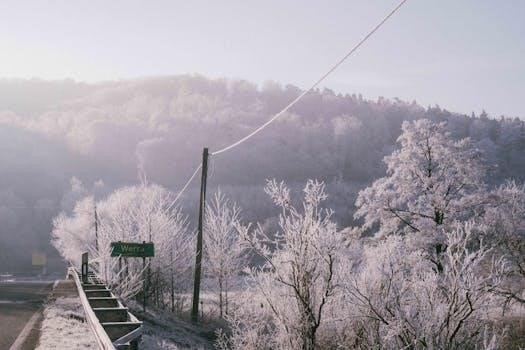Robert Frost’s Life and Career
Robert Frost, a quintessential American poet, is celebrated for his depictions of rural New England life. His poetry explores themes of nature, choice, and human experience; Frost’s colloquial style and insightful observations secured his place as a literary icon, earning him four Pulitzer Prizes. He remains widely studied.

“The Road Not Taken”⁚ An Overview
“The Road Not Taken,” penned by Robert Frost in 1915 and published in 1916, stands as one of American literature’s most iconic poems. Its deceptively simple narrative explores the universal human experience of decision-making. The poem presents a speaker encountering a fork in a road, symbolizing life’s choices and their lasting consequences.
The poem’s enduring appeal lies in its accessibility and relatable theme. It captures the weight of decisions and the uncertainty of the paths we choose. The speaker’s contemplation at the crossroads reflects the human tendency to ponder “what if” scenarios.
While often interpreted as a celebration of individuality, the poem’s true message is more nuanced. It delves into the complexities of choice, regret, and the subjective nature of how we perceive our past decisions. The road “less traveled by” may not necessarily be the better option, but rather the one that shapes our unique narrative. The poem invites readers to reflect on their own journeys and the roads they have taken.
Text of the Poem
Two roads diverged in a yellow wood,
And sorry I could not travel both
And be one traveler, long I stood
And looked down one as far as I could
To where it bent in the undergrowth;
Then took the other, as just as fair,
And having perhaps the better claim,
Because it was grassy and wanted wear;
Though as for that the passing there
Had worn them really about the same,
And both that morning equally lay
In leaves no step had trodden black.
Oh, I kept the first for another day!
Yet knowing how way leads on to way,
I doubted if I should ever come back.
I shall be telling this with a sigh
Somewhere ages and ages hence⁚
Two roads diverged in a wood, and I—
I took the one less traveled by,
And that has made all the difference.

Analysis of the Poem’s Title
The title, “The Road Not Taken,” immediately draws the reader’s attention to the concept of choice and its potential impact. It suggests a reflection on paths diverged and decisions made, hinting at a sense of longing or contemplation. The phrase itself is deceptively simple, yet it carries a profound weight, implying that the road not chosen holds significance.
The title sets the stage for the poem’s exploration of decision-making and the human tendency to ponder “what ifs.” It invites us to consider the roads we haven’t traveled and the potential consequences of those untaken paths. The word “taken” emphasizes the action of choosing, highlighting the agency and responsibility involved in shaping one’s own destiny.
Furthermore, the title’s ambiguity allows for multiple interpretations. It could be interpreted as a celebration of individuality, as the speaker seemingly embraces the less conventional route. Alternatively, it could be seen as a lament for lost opportunities, as the speaker acknowledges the impossibility of experiencing all possible paths. This inherent ambiguity contributes to the poem’s enduring appeal and its ability to resonate with readers on a personal level. Ultimately, the title serves as a powerful invitation to contemplate the complexities of choice and the lasting impact of our decisions.
Stanza-by-Stanza Analysis
Each stanza of “The Road Not Taken” contributes to the poem’s overarching theme of choice. The poem uses a road as a metaphor. Examining each stanza reveals the speaker’s thought process. The stanzas ultimately explain the consequences and reflections on decisions that shape one’s life.
First Stanza
The opening stanza introduces the central image of the diverging roads set “in a yellow wood.” This establishes the poem’s setting and introduces the speaker’s dilemma. The “yellow wood” evokes a sense of autumn, symbolizing a time of transition and decision.
The speaker expresses regret (“sorry I could not travel both”) at being unable to experience both paths simultaneously. This regret emphasizes the exclusivity of choices; selecting one inherently means forgoing the other. The speaker’s prolonged contemplation (“long I stood”) highlights the significance of the decision.
The act of looking “down one as far as I could / To where it bent in the undergrowth” signifies the speaker’s attempt to foresee the consequences of each path. However, the obscured view suggests the inherent uncertainty of future outcomes. This encapsulates the human tendency to analyze and predict, yet our limited ability to truly know the future.
This stanza encapsulates the initial moment of decision, the regret of lost possibilities, and the attempt to anticipate the unknown.
Second Stanza
The second stanza details the speaker’s choice of the road “as just as fair.” This suggests that neither path initially appears more appealing or advantageous. The speaker’s reasoning for selecting the other road lies in its perceived lack of wear⁚ “Because it was grassy and wanted wear.”
This line is crucial and open to interpretation. It could indicate a desire for novelty, a preference for the less conventional, or a belief that the less-traveled path holds greater potential. However, the subsequent lines complicate this notion.
The speaker qualifies the previous statement, admitting that “the passing there / Had worn them really about the same.” This undermines the initial justification for choosing the less-traveled road. It introduces an element of ambiguity, suggesting that the perceived difference between the paths may be illusory.
The second stanza highlights the subjective nature of decision-making. The initial rationale is undermined, leaving the reader to question the true basis for the speaker’s choice. This ambiguity contributes to the poem’s enduring appeal and its capacity for diverse interpretations.
Third Stanza
The third stanza reflects on the speaker’s choice and its potential consequences. He acknowledges that both roads that morning equally lay, and leaves no step had trodden black. This suggests that both paths were equally untrodden and held similar opportunities. The speaker expresses doubt that he should ever come back, realizing that life’s journey rarely allows for revisiting past decisions.
This stanza introduces a sense of finality and the understanding that choices have lasting effects. The road not taken remains a path unexplored, a possibility forever closed off. The speaker’s acceptance of this reality adds a layer of wistful contemplation to the poem.
The lines also imply a recognition that life is a forward-moving process, where each choice shapes the future and makes certain possibilities unattainable. This stanza underscores the weight of decisions and the irreversible nature of time, reinforcing the poem’s themes of choice and consequence. The speaker’s reflection emphasizes the profound impact of even seemingly small decisions.
Fourth Stanza
The final stanza offers a reflection on the speaker’s future retelling of this experience. The speaker envisions recounting this decision with a sigh, somewhere ages and ages hence. This sigh could represent either regret or satisfaction. He states that he took the one less traveled by, and that has made all the difference. This line is often misinterpreted.
The speaker isn’t necessarily saying that the road was actually less traveled, or that it even made him better to take it. Instead, he is saying that he will tell himself that he took the road less traveled as a way to justify all the events that happened. This is where the poem’s ambiguity shines.
The last line doesn’t necessarily mean that he is happy with his choice, but rather that he is trying to convince himself that it mattered. The speaker is trying to give meaning to a decision that may have been arbitrary. It speaks to our human need to create narratives about our lives and choices.

Themes in “The Road Not Taken”
The central theme revolves around choices and their lasting impact. The poem delves into the complexities of decision-making, highlighting how even seemingly small choices can shape the course of one’s life. The road symbolizes the various paths we encounter, each presenting different opportunities and challenges.
Another prominent theme is individuality. The speaker’s decision to take the road “less traveled by” suggests a desire to forge a unique path, even if it means deviating from the norm. The poem explores the tension between conformity and nonconformity, and the potential rewards and consequences of choosing the latter.
Ambiguity is also a key theme. The poem’s ending is open to interpretation, leaving readers to ponder whether the speaker is ultimately content or regretful about the choice. This ambiguity invites introspection about the nature of choice and the human tendency to create narratives around our decisions.
Misinterpretations of the Poem
One common misinterpretation is viewing the poem as a celebration of nonconformity and taking the less popular option. Many assume the speaker is proud of choosing the road “less traveled by,” believing it led to a more fulfilling life. However, a closer look reveals a more nuanced perspective.
The poem doesn’t explicitly state that the road was indeed less traveled, nor does it imply that the speaker’s choice was necessarily better. In fact, the speaker admits the paths were “really about the same,” suggesting the decision was rather arbitrary.
Another misinterpretation is romanticizing the idea of forging one’s own path; The poem doesn’t necessarily advocate for always choosing the unconventional option. It simply presents a moment of decision and the speaker’s subsequent reflection.
The poem’s ambiguity allows for multiple interpretations. Some read it as a commentary on the human tendency to create narratives around our choices, often exaggerating the significance of our decisions in retrospect;

The Poem’s Connection to Edward Thomas
“The Road Not Taken” was inspired by Robert Frost’s walks with his friend, the Welsh poet Edward Thomas, in the English countryside. Thomas was known for his indecisiveness and frequent regrets about the paths not taken during their walks. He would often lament the missed opportunities of the road they didn’t choose.
Frost wrote the poem partly as a gentle teasing of Thomas’s personality. The poem captures Thomas’s tendency to dwell on alternative possibilities and his romanticizing of the road not taken. However, it’s important to note that Frost’s poem is not simply a direct representation of Thomas’s specific experiences.
The poem transcends its personal origins to explore universal themes of choice, regret, and the human tendency to create narratives around our decisions. While inspired by Thomas, the poem speaks to a broader human experience of navigating life’s many diverging paths. The irony is that Thomas himself never fully grasped the poem’s intent.
